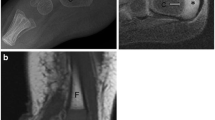Abstract
Background
We have clinically encountered children with fibrodysplasia ossificans progressiva who had abnormal calcaneal ossification.
Objective
To evaluate whether calcaneal ossification variants are significant radiographic findings in children with fibrodysplasia ossificans progressiva.
Materials and methods
Lateral feet radiographs in nine children who fulfilled the diagnostic criteria of fibrodysplasia ossificans progressiva were reviewed. The studies were obtained during infancy or early childhood.
Results
Fourteen lateral foot radiographs of fibrodysplasia ossificans progressiva were available for this study (ages at examination: 1-104 months). Four children ages 2 months to 11 months showed double calcaneal ossification centers; 7 children had plantar calcaneal spurs that decreased in size with age. Overall, eight of nine children with fibrodysplasia ossificans progressiva demonstrated double calcaneal ossifications and/or plantar calcaneal spurs in infancy or childhood.
Conclusion
Double calcaneal ossification centers in early infancy and plantar calcaneal spurs in childhood are frequently seen in children with fibrodysplasia ossificans progressiva and may be a useful radiologic indicator for early diagnosis.





Similar content being viewed by others
References
Shore EM, Xu M, Feldman GJ et al (2006) A recurrent mutation in the BMP type I receptor ACVR1 causes inherited and sporadic fibrodysplasia ossificans progressiva. Nat Genet 38:525–527
Pignolo RJ, Shore EM, Kaplan FS (2013) Fibrodysplasia ossificans progressiva: diagnosis, management, and therapeutic horizons. Pediatr Endocrinol Rev 10:437–448
Nakashima Y, Haga N, Kitoh H et al (2010) Deformity of the great toe in fibrodysplasia ossificans progressiva. J Orthop Sci 15:804–809
Mishima K, Kitoh H, Katagiri T et al (2011) Early clinical and radiographic characteristics in fibrodysplasia ossificans progressiva: a report of two cases. J Bone Joint Surg Am 93, e52
Mishima K, Kitoh H, Haga N et al (2014) Radiographic characteristics of the hand and cervical spine in fibrodysplasia ossificans progressiva. Intractable Rare Dis Res 3:46–51
van Wiechen PJ (1987) Reversed calcaneal spurs in children. Skeletal Radiol 16:17–18
Robinson HM (1976) Symmetrical reversed plantar calcaneal spurs in children. A normal variant? Radiology 119:187–188
Sever JW (1930) Bifid os calcis. Surg Gynecol Obstet 50:1012–1013
Ogden JA (1982) Anomalous multifocal ossification of the os calcis. Clin Orthop Relat Res 162:112–118
Szaboky GT, Anderson JJ, Wiltsie RA (1970) Bifid os calcis. An anomalous ossification of the calcaneus. Clin Orthop Relat Res 68:136–137
Cormier-Daire V, Savarirayan R, Unger S et al (2001) “Duplicate Calcaneus”: a rare developmental defect observed in several skeletal dysplasias. Pediatr Radiol 31:38–42
Krakow D, Robertson SP, King LM et al (2004) Mutations in the gene encoding filamin B disrupt vertebral segmentation, joint formation and skeletogenesis. Nat Genet 36:405–410
Zheng L, Baek HJ, Karsenty G et al (2007) Filamin B represses chondrocyte hypertrophy in a Runx2/Smad3-dependent manner. J Cell Biol 178:121–128
Acknowledgments
The authors appreciate members of skeldys.org for their enthusiastic web discussion concerning patients 2 and 3. This work was supported in partly by Research Committee on Fibrodysplasia Ossificans Progressiva from the Ministry of Health, Labor and Welfare of Japan.
Author information
Authors and Affiliations
Corresponding author
Ethics declarations
Conflicts of interest
None
Rights and permissions
About this article
Cite this article
Hasegawa, S., Victoria, T., Kayserili, H. et al. Characteristic calcaneal ossification: an additional early radiographic finding in infants with fibrodysplasia ossificans progressiva. Pediatr Radiol 46, 1568–1572 (2016). https://doi.org/10.1007/s00247-016-3662-3
Received:
Revised:
Accepted:
Published:
Issue Date:
DOI: https://doi.org/10.1007/s00247-016-3662-3




